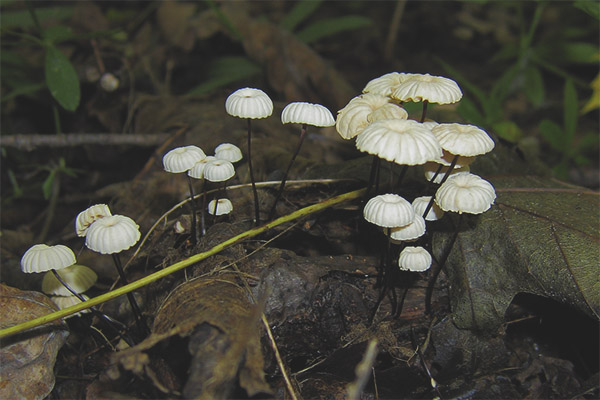The content of the article
Wheel-shaped nebniyachnik is an inedible type of mushroom belonging to the family of non-leaf plants. The Latin name for this species is Marasmius rotula.
Description
The cap of representatives of this type of mushrooms is rather modest in size and reaches only 10-15 mm in diameter. At the beginning of development, the shape of this part of the fungus is spherical, with the growth it straightens and becomes more prostrate. In the central part of the cap, one can notice a characteristic, albeit narrow, but rather deep hollow. Directly, the surface of the cap itself has a fibrous structure, which makes it possible to see well all its details (hillocks, hollows). At the first glance at the mushroom, it may seem that the cap of the negunichnik has absolutely no flesh, however, the latter is very thin and practically visually inseparable from the lamellar body.The head of specimens at the beginning of growth is very light, with the growth of the fungus acquires a gray-yellow color. The aroma of the pulp, although weak, is quite sharp.
Plates of white color are located with small gaps, most often they adhere to the characteristic collar bordering the leg of the fungus. Spore powder has the same color as the plate body.
The non-neychnichi has a rather thin leg, the length of which reaches 80 mm. This part of the fungus is dark, almost black at the base.
Distribution of species
Similarities with other species
Often, this type of inedible fungi is confused with the Bullyar's nebnychnik, which has almost the same appearance (the white color of the fruit body, and a characteristic wheel-like shape).However, the main difference of the wheel-shaped non-brazer is the presence of a pronounced collar, located in the upper part of the leg, to which the plates descending from the lamellar body are attached.
Edibility

According to the available information, the wheelhouse nondiichnik does not belong to poisonous species of mushrooms, however, it is also not used in cooking, which is due to its very modest size.
Features of the form
The main feature of this type of mushroom is that in dry periods negnichniki almost completely shrink, however, this does not mean their total death. With the beginning of the rainy season, the representatives of this species completely restore their former form, and they again begin to bear fruit and grow.
I would like to draw attention to the fact that this type of mushroom, in fact, has no practical value. The only thing that is highlighted by scientists is an enzyme like MroAPO contained in this mushroom, which is a kind of biosensor used for the analysis of aromatic substances.
Other negunichniki
The family of mushrooms Marasmius includes about 500 different species, and only a small part of them is edible. Other species are usually not collected, often the reason for this is the unattractive appearance of mushrooms and their modest size.
Such a species as a gentle nonchyle is a modest-sized fungus that does not have any nutritional value. At the beginning of development, the specimens of this species have a hemispherical cap, which expands with the growth of the mushroom. Adult mushrooms in the center of the cap have a small tubercle of characteristic dark brick color.The body of the cap is rather thin, the edge is wavy with rare radial folds. At the beginning of development, the cap has a white color, with the growth of mushrooms darkens. The leg, like the cap, is a rich brown color. The peak of fruiting of this type of Negnichnik from mid-summer to mid-autumn. Most often, these mushrooms are found in forests of mixed type.











To send